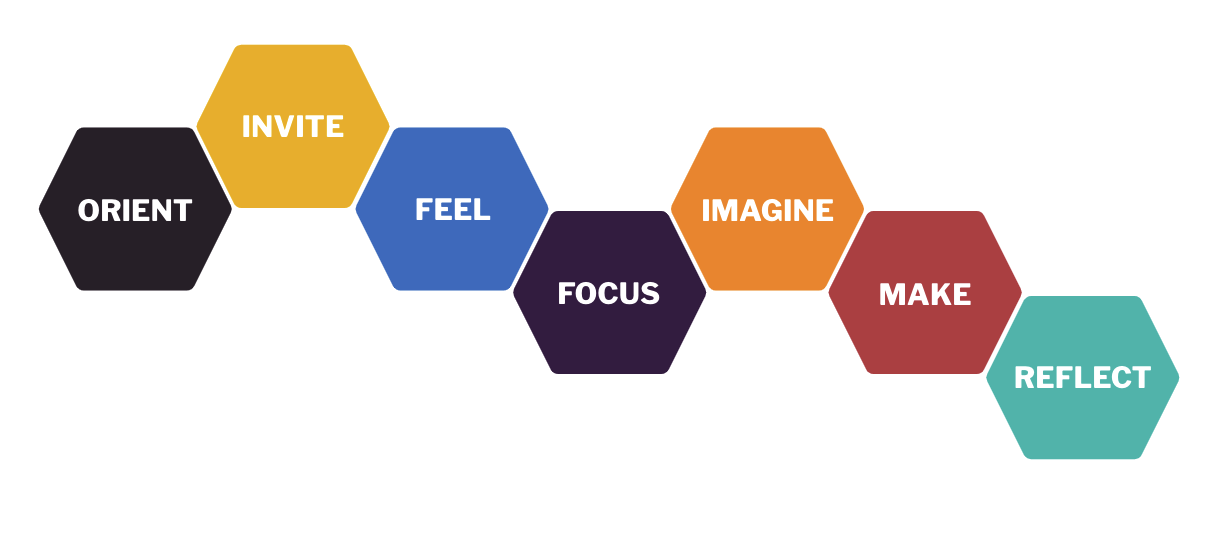Our approach to co-creating positive change is highly collaborative and adapted to the needs and circumstances of each client, end user and community.
“Design with not for”
Orient
Before we explore, we take in our surroundings and get our bearings. We want to understand as much as we can as quickly as we can about the opportunities, the needs, and the history of the community we seek to serve. We dig into existing knowledge and connect with subject matter experts and people with lived experience to form some early hypotheses. And we try to intentionally examine our own involuntary responses, systemic biases, power structures and any obstacles to creating a positive outcome. We map systems and power and identify and name inequities that may work to thwart a positive solution.
INVITE
A key element of the Equity-Centered Design approach is inviting a diverse team of collaborators. Diversity helps us imagine and create a broader range of possible solutions. Being intentional at the outset about inviting a variety of collaborators with diverse life experiences increases our chances of creating good solutions that meet community needs and provide long-term sustainability.
FEEL
Deep community engagement is the next step. We use qualitative and ethnographic research methods to deepen our understanding of the issues and systems involved and to ensure community needs and points of view are thoroughly expressed and at the forefront of our work going forward.
FOCUS
This step is perhaps the most critical of the entire journey. We unpack all of the findings and feelings of the previous two phases, we group them and sort them to find connections and meaning, and we ask questions about the things we've found. Often we do this with end users or community members as a collaborative endeavor, to co-create the outcome of this stage, our problem question. This is the key question that will guide the rest of the process.
IMAGINE
Imagining possible solutions is the fun part. Our approach to this task is based on the principle of designing with not for the community we seek to serve. We convene co-creation sessions with community members and use research-backed techniques to generate both a quantity and quality of ideas. Our facilitation methods are designed to ensure that everyone gets a voice and that ideas from disparate viewpoints are included. We draw on an international network of subject matter experts and provocateurs who can stimulate discussion and new ideas.
Make
We move quickly from imagining to doing. We quickly make simple, physical and digital prototypes and get them into the hands of our users and communities. We get feedback fast, so we can iterate, and more importantly, so that we can learn.
REFLECt
As we take our ideas into the world, we do so with an important mindset. We aren't just trying to refine the ideas so we can launch them. Every iteration is a chance to learn more about the community, the systems, and the impacts, intended and otherwise. It's a chance to uncover a new insight that may change the idea, lead us in a better direction. A heathy dose of humility is important in this phase, as learning can often uncover assumptions that were unjustified. But through the learning process, the team becomes not only better able to make this idea successful, they gain increased capacity to execute new ideas that improve impact throughout the organization.
RESOURCES
Equity-Centered Design (ECD) is a refinement of Design Thinking (or Human-Centered Design). Where traditional Design Thinking emphasizes the empathy and creativity of a core design team, ECD emphasizes humility, co-creation, and an analysis of systems and inequities that can work against solutions. ECD is
Stanford D School
One of the most prominent proponents of Design Thinking, they offer an abundance of resources.
Getting Started with Design Thinking
Equity Centered Design Framework
Greater Good Studio
George Aye and Sara Cantor Aye and their team at Greater Good have created an amazing studio using Human-Centered Design for social good.
Creative Reaction Lab
Antionette Carroll, founder of Creative Reaction Lab in St. Louis, has done terrific work in adapting Design Thinking for diversity and inclusion. Download their Equity-Centered Community Field Guide.
National Equity Project
This organization offers leaders in education frameworks for transforming systems and building equity. Their Introduction to Liberatory Design is a good resource for equity-minded change makers.


